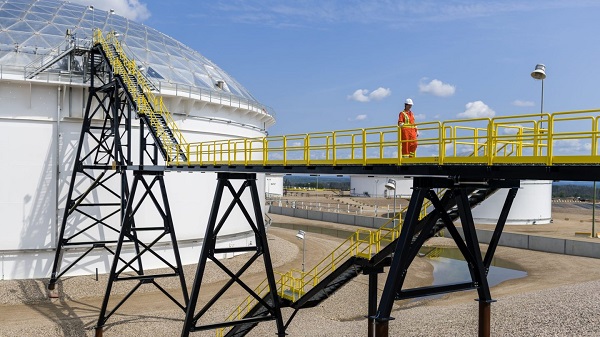Canadian Energy Centre
Why Canadian oil is so important to the United States

From the Canadian Energy Centre
Complementary production in Canada and the U.S. boosts energy security
The United States is now the world’s largest oil producer, but its reliance on oil imports from Canada has never been higher.
Through a vast handshake of pipelines and refineries, Canadian oil and U.S. oil complement each other, strengthening North American energy security.
Here’s why.
Decades in the making
Twenty years ago, the North American energy market looked a lot different than it does today.
In the early 2000s, U.S. oil production had been declining for more than 20 years. By 2005, it dropped to its lowest level since 1949, according to the U.S. Energy Information Administration (EIA).
America’s imports of oil from foreign nations were on the rise.
But then, the first of two powerhouse North American oil plays started ramping up.
In Canada’s oil sands, a drilling technology called SAGD – steam-assisted gravity drainage – unlocked enormous resources that could not be economically produced by the established surface mining processes. And the first new mines in nearly 25 years started coming online.
In about 2010, the second massive play – U.S. light, tight oil – emerged on the scene, thanks to hydraulic fracturing technology.
Oil sands production jumped from about one million barrels per day in 2005 to 2.5 million barrels per day in 2015, reaching an average 3.5 million barrels per day last year, according to the Canada Energy Regulator.
Meanwhile, U.S. oil production skyrocketed from 5.5 million barrels per day in 2005 to 9.4 million barrels per day in 2015 and 13.3 million barrels per day in 2024, according to the EIA.
Together the United States and Canada now produce more oil than anywhere else on earth, according to S&P Global.
As a result, overall U.S. foreign oil imports declined by 35 per cent between 2005 and 2023. But imports from Canada have steadily gone up.
In 2005, Mexico, Saudi Arabia, Venezuela and Nigeria together supplied 52 per cent of U.S. oil imports. Canada was at just 16 per cent.
In 2024, Canada supplied 62 per cent of American oil imports, with Mexico, Saudi Arabia and Venezuela together supplying just 14 per cent, according to the EIA.
“Light” and “heavy” oil
Canadian and U.S. oil production are complementary because they are different from each other in composition.
Canada’s oil exports to the U.S. are primarily “heavy” oil from the oil sands, while U.S. production is primarily “light” oil from the Permian Basin in Texas and New Mexico.
One way to think of it is that heavy oil is thick and does not flow easily, while light oil is thin and flows freely – like orange juice compared to fudge.
The components that make the oil like this require different refinery equipment to generate products including gasoline, jet fuel and base petrochemicals.
Of the oil the U.S. imported from Canada from January to October last year, 75 per cent was heavy, six per cent was light, and the remaining 19 per cent was “medium,” which basically has qualities in between the two.
Tailored for Canadian crude
Many refineries in the United States are specifically designed to process heavy oil, primarily in the U.S. Midwest and U.S. Gulf Coast.
Overall, there are about 130 operable oil refineries in the United States, according to the American Fuel and Petrochemical Manufacturers.
The Alberta Petroleum Marketing Commission (APMC) estimates that 25 consistently use oil from Alberta.
According to APMC, the top five U.S. refineries running the most Alberta crude are:
- Marathon Petroleum, Robinson, Illinois (100% Alberta crude)
- Exxon Mobil, Joliet, Illinois (96% Alberta crude)
- CHS Inc., Laurel, Montana (95% Alberta crude)
- Phillips 66, Billings, Montana (92% Alberta crude)
- Citgo, Lemont, Illinois (78% Alberta crude)
Since 2010, virtually 100 per cent of oil imports to the U.S. Midwest have come from Canada, according to the EIA.
In recent years, new pipeline access and crude-by-rail have allowed more Canadian oil to reach refineries on the U.S. Gulf Coast, rising from about 140,000 barrels per day in 2010 to about 450,000 barrels per day in 2024.
U.S. oil exports
The United States banned oil exports from 1975 to the end of 2015. Since, exports have surged, averaging 4.1 million barrels per day last year, according to the EIA.
That is nearly equivalent to the 4.6 million barrels per day of Canadian oil imported into the U.S. over the same time period, indicating that Canadian crude imports enable sales of U.S. oil to global markets.
Future outlook
Twenty-five years from now, the U.S. will need to import virtually exactly the same amount of oil as it does today (7.0 million barrels per day in 2050 compared to 6.98 million barrels per day in 2023), according to the EIA.
Alberta
‘Weird and wonderful’ wells are boosting oil production in Alberta and Saskatchewan

From the Canadian Energy Centre
Multilateral designs lift more energy with a smaller environmental footprint
A “weird and wonderful” drilling innovation in Alberta is helping producers tap more oil and gas at lower cost and with less environmental impact.
With names like fishbone, fan, comb-over and stingray, “multilateral” wells turn a single wellbore from the surface into multiple horizontal legs underground.
“They do look spectacular, and they are making quite a bit of money for small companies, so there’s a lot of interest from investors,” said Calin Dragoie, vice-president of geoscience with Calgary-based Chinook Consulting Services.
Dragoie, who has extensively studied the use of multilateral wells, said the technology takes horizontal drilling — which itself revolutionized oil and gas production — to the next level.
“It’s something that was not invented in Canada, but was perfected here. And it’s something that I think in the next few years will be exported as a technology to other parts of the world,” he said.
Dragoie’s research found that in 2015 less than 10 per cent of metres drilled in Western Canada came from multilateral wells. By last year, that share had climbed to nearly 60 per cent.
Royalty incentives in Alberta have accelerated the trend, and Saskatchewan has introduced similar policy.
Multilaterals first emerged alongside horizontal drilling in the late 1990s and early 2000s, Dragoie said. But today’s multilaterals are longer, more complex and more productive.
The main play is in Alberta’s Marten Hills region, where producers are using multilaterals to produce shallow heavy oil.
Today’s average multilateral has about 7.5 horizontal legs from a single surface location, up from four or six just a few years ago, Dragoie said.
One record-setting well in Alberta drilled by Tamarack Valley Energy in 2023 features 11 legs stretching two miles each, for a total subsurface reach of 33 kilometres — the longest well in Canada.
By accessing large volumes of oil and gas from a single surface pad, multilaterals reduce land impact by a factor of five to ten compared to conventional wells, he said.
The designs save money by skipping casing strings and cement in each leg, and production is amplified as a result of increased reservoir contact.
Here are examples of multilateral well design. Images courtesy Chinook Consulting Services.
Parallel
Fishbone
Fan
Waffle
Stingray
Frankenwells
Alberta
How economic corridors could shape a stronger Canadian future

Ship containers are stacked at the Panama Canal Balboa port in Panama City, Saturday, Sept. 20, 2025. The Panama Canals is one of the most significant trade infrastructure projects ever built. CP Images photo
From the Canadian Energy Centre
Q&A with Gary Mar, CEO of the Canada West Foundation
Building a stronger Canadian economy depends as much on how we move goods as on what we produce.
Gary Mar, CEO of the Canada West Foundation, says economic corridors — the networks that connect producers, ports and markets — are central to the nation-building projects Canada hopes to realize.
He spoke with CEC about how these corridors work and what needs to change to make more of them a reality.
CEC: What is an economic corridor, and how does it function?
Gary Mar: An economic corridor is a major artery connecting economic actors within a larger system.
Consider the road, rail and pipeline infrastructure connecting B.C. to the rest of Western Canada. This infrastructure is an important economic corridor facilitating the movement of goods, services and people within the country, but it’s also part of the economic corridor connecting western producers and Asian markets.
Economic corridors primarily consist of physical infrastructure and often combine different modes of transportation and facilities to assist the movement of many kinds of goods.
They also include social infrastructure such as policies that facilitate the easy movement of goods like trade agreements and standardized truck weights.
The fundamental purpose of an economic corridor is to make it easier to transport goods. Ultimately, if you can’t move it, you can’t sell it. And if you can’t sell it, you can’t grow your economy.
CEC: Which resources make the strongest case for transport through economic corridors, and why?
Gary Mar: Economic corridors usually move many different types of goods.
Bulk commodities are particularly dependent on economic corridors because of the large volumes that need to be transported.
Some of Canada’s most valuable commodities include oil and gas, agricultural commodities such as wheat and canola, and minerals such as potash.
CEC: How are the benefits of an economic corridor measured?
Gary Mar: The benefits of economic corridors are often measured via trade flows.
For example, the upcoming Roberts Bank Terminal 2 in the Port of Vancouver will increase container trade capacity on Canada’s west coast by more than 30 per cent, enabling the trade of $100 billion in goods annually, primarily to Asian markets.
Corridors can also help make Canadian goods more competitive, increasing profits and market share across numerous industries. Corridors can also decrease the costs of imported goods for Canadian consumers.
For example, after the completion of the Trans Mountain Expansion in May 2024 the price differential between Western Canada Select and West Texas Intermediate narrowed by about US$8 per barrel in part due to increased competition for Canadian oil.
This boosted total industry profits by about 10 per cent, and increased corporate tax revenues to provincial and federal governments by about $3 billion in the pipeline’s first year of operation.
CEC: Where are the most successful examples of these around the world?
Gary Mar: That depends how you define success. The economic corridors transporting the highest value of goods are those used by global superpowers, such as the NAFTA highway that facilitates trade across Canada, the United States and Mexico.
The Suez and Panama canals are two of the most significant trade infrastructure projects ever built, facilitating 12 per cent and five per cent of global trade, respectively. Their success is based on their unique geography.
Canada’s Asia-Pacific Gateway, a coordinated system of ports, rail lines, roads, and border crossings, primarily in B.C., was a highly successful initiative that contributed to a 48 per cent increase in merchandise trade with Asia from $44 million in 2006 to $65 million in 2015.
China’s Belt and Road initiative to develop trade infrastructure in other countries is already transforming global trade. But the project is as much about extending Chinese influence as it is about delivering economic returns.

Piles of coal awaiting export and gantry cranes used to load and unload containers onto and from cargo ships are seen at Deltaport, in Tsawwassen, B.C., on Monday, September 9, 2024. CP Images photo
CEC: What would need to change in Canada in terms of legislation or regulation to make more economic corridors a reality?
Gary Mar: A major regulatory component of economic corridors is eliminating trade barriers.
The federal Free Trade and Labour Mobility in Canada Act is a good start, but more needs to be done at the provincial level to facilitate more internal trade.
Other barriers require coordinated regulatory action, such as harmonizing weight restrictions and road bans to streamline trucking.
By taking a systems-level perspective – convening a national forum where Canadian governments consistently engage on supply chains and trade corridors – we can identify bottlenecks and friction points in our existing transportation networks, and which investments would deliver the greatest return on investment.
-

 Alberta1 day ago
Alberta1 day agoNet Zero goal is a fundamental flaw in the Ottawa-Alberta MOU
-

 Food1 day ago
Food1 day agoCanada Still Serves Up Food Dyes The FDA Has Banned
-

 National2 days ago
National2 days agoEco-radical Canadian Cabinet minister resigns after oil deal approved
-

 Addictions1 day ago
Addictions1 day agoManitoba Is Doubling Down On A Failed Drug Policy
-

 COVID-191 day ago
COVID-191 day agoThe dangers of mRNA vaccines explained by Dr. John Campbell
-

 Artificial Intelligence16 hours ago
Artificial Intelligence16 hours ago‘Trouble in Toyland’ report sounds alarm on AI toys
-

 COVID-191 day ago
COVID-191 day agoFDA says COVID shots ‘killed’ at least 10 children, promises new vaccine safeguards
-

 Alberta1 day ago
Alberta1 day agoKeynote address of Premier Danielle Smith at 2025 UCP AGM


















